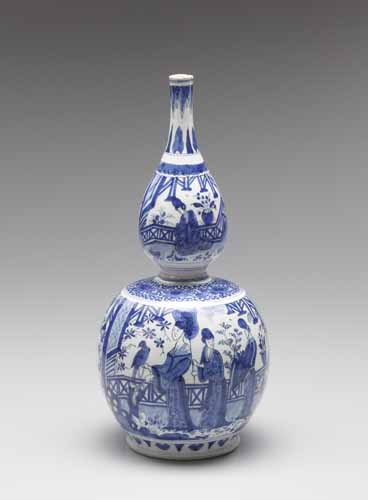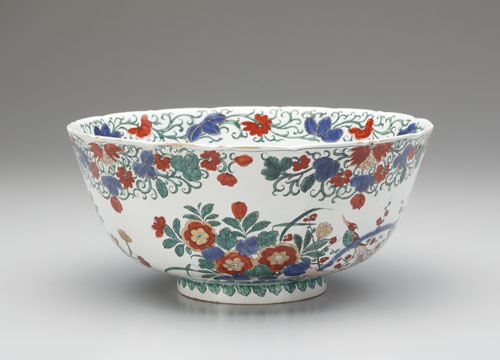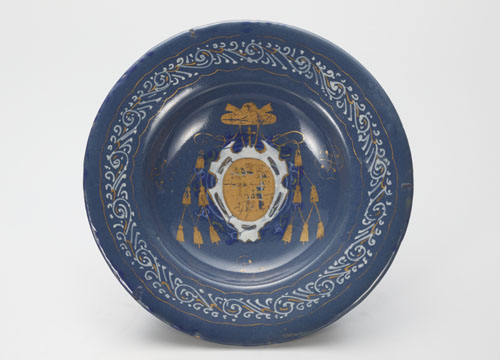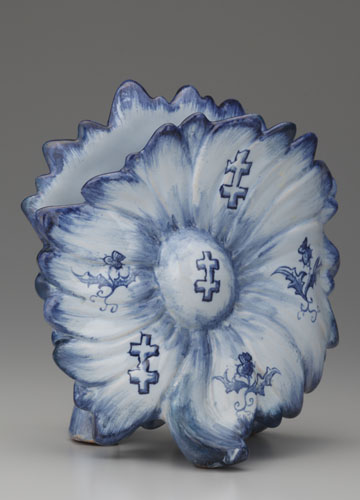- Calendar
- Online Ticket Sales
- Access
- JA
- EN
The Collectors` Eye: Suntory Museum of Art Recent Acquisitions
Ceramics from Europe and Glass from Around the World
January 25 to March 12, 2017
*There may be an exhibition change during the course of exhibition.
*Download the list of changes in works on display
The list of changes in worksPDF
Noyori Toshiyuki Collection of European Ceramics
As an art dealer, Noyori Toshiyuki has played a key role in bringing many important Art Nouveau works, especially outstanding works by Emile Gallé, to Japan. He has also provided critical support for earlier exhibitions featuring glass at the Suntory Museum of Art.
Noyori’s interest in art was not confined to glass. Apart from his professional activities, he collected a wide range of works of art and craft objects, choosing works moved him, regardless of field, region, or period. He did not choose works because they were glass or ceramics. That made no difference to him. He chose works instinctively, based on his immediate reaction to them: things that were beautiful or enchanting. In the silk pouches of fabrics with unusual motifs made for each Delftware bowl or small jar, for example, we see his great love for each of them. His donation of these ceramic vessels was inspired by his hope that they would be useful in our research.
Dutch Delftware is the core of the Noyori collection of European ceramics. Delftware, with its cobalt blue patterns on a white ground, remains a Dutch cultural icon today.
Production of Delftware flourished from the late seventeenth to the early eighteenth centuries. With exotic Oriental motifs inspired by those found on Chinese and Japanese porcelain, Delftware took Europe by storm. Works in that Oriental taste make up the bulk of the Noyori collection.
The Noryori collection also includes a wide range of other ceramics, from maiolica, the Italian ceramics from which Delftware evolved, to works by the brilliant modernera French glass artist Emile Gallé.

Netherlands; 17th century
Suntory Museum of Art (donated by Noyori Toshiyuki)

Netherlands; 17th–18th century
Suntory Museum of Art (donated by Noyori Toshiyuki)

Netherlands; 18th century
Suntory Museum of Art (donated by Noyori Toshiyuki)

Netherlands; 18th century
Suntory Museum of Art (donated by Noyori Toshiyuki)

Netherlands; 18th century
Suntory Museum of Art (donated by Noyori Toshiyuki)

Italy; 16th century
Suntory Museum of Art (donated by Noyori Toshiyuki)

Emile Gallé
France; ca.1881–1885
Suntory Museum of Art (donated by Noyori Toshiyuki)
Tsuji Seimei Collection: Glass from Around the World
Tsuji Seimei (1927-2008) began working at the potter’s wheel around the age of ten. He produced primarily yakishime (high-fired, unglazed) pottery, especially of the type produced in Shigaraki. As a potter with his own distinctive aesthetic sensibility, his aim was a “bright simplicity,” combining boundless subtle feeling with a gorgeous brightness in tone. While famous as a potter, he was also a renowned collector, whose passion for antiques was unconfined by category. At the age of four or five, he was already accompanying his father as on visits to antique dealers, where he was allowed to touch antiques and sharpen his connoisseur’s eye. He began collecting when his father gave him Nonomura Ninsei’s Incense Burner in the Shape of a Rooster as a birthday present on his ninth birthday.
Wood, ceramics, lacquer, metal: Tsuji’s collecting took many twists and turns through materials, eras, and regions. Early on, however, he became entranced by glass. Because glass is produced by firing at high temperatures, he sensed its close connection with pottery. It also shared with pottery a special quality deepened and changed by passing through many hands and environments. He said that glass’s greatest glamour was, however, its “transparency,” its “prism-like brilliance,” and its “ever-changing appearance.” Glass both shared familiar features of clay and was, at the same time, its polar opposite in terms of its transparency, its sparkle. There must have been many times when Tsuji, still thinking about this fascinating material, returned to creating opaque pottery.
The Tsuji Glass Collection, which is now part of the Suntory Museum of Art’s holdings, ranges from ancient Roman through Oriental, Chinese, European and Japanese glass. We feel extraordinarily lucky to be able to explore this wonderfully varied world of glass, so filled with fated relationships, moments of affection, and multiple conversations.

Italy or eastern Mediterranean; Mid 4th–early 3rd century BCE
Suntory Museum of Art (Tsuji Seimei Collection)

Eastern Mediterranean; 1st century BCE to 1st century
Suntory Museum of Art (Tsuji Seimei Collection)

Iran; 3rd–7th century
Suntory Museum of Art (Tsuji Seimei Collection)

China; Qianlong era, 18th century
Suntory Museum of Art (Tsuji Seimei Collection)

Glass: England, Engraving: Dresden, Saxony; Germany; 1760
Suntory Museum of Art (Tsuji Seimei Collection)

Japan; Edo period, 18th century
Suntory Museum of Art (Tsuji Seimei Collection)

Japan; Late Edo–early Meiji period, 19th century
Suntory Museum of Art (Tsuji Seimei Collection)

Tsuji Seimei; 1991
Suntory Museum of Art (Tsuji Seimei Collection)
*Unauthorized reproduction or use of texts or images from this site is prohibited.
2024 January
- Exhibition
- Closed
- Tea Ceremony
- Mon
- Tue
- Wed
- Thu
- Fri
- Sat
- Sun
- 1
- 2
- 3
- 4
- 5
- 6
- 7
- 8
- 9
- 10
- 11
- 12
- 13
- 14
- 15
- 16
- 17
- 18
- 19
- 20
- 21
- 22
- 23
- 24
- 25
- 26
- 27
- 28
- 29
- 30
- 31
2024 February
- Exhibition
- Closed
- Tea Ceremony
- Mon
- Tue
- Wed
- Thu
- Fri
- Sat
- Sun
- 1
- 2
- 3
- 4
- 5
- 6
- 7
- 8
- 9
- 10
- 11
- 12
- 13
- 14
- 15
- 16
- 17
- 18
- 19
- 20
- 21
- 22
- 23
- 24
- 25
- 26
- 27
- 28
- 29
2024 March
- Exhibition
- Closed
- Tea Ceremony
- Mon
- Tue
- Wed
- Thu
- Fri
- Sat
- Sun
- 1
- 2
- 3
- 4
- 5
- 6
- 7
- 8
- 9
- 10
- 11
- 12
- 13
- 14
- 15
- 16
- 17
- 18
- 19
- 20
- 21
- 22
- 23
- 24
- 25
- 26
- 27
- 28
- 29
- 30
- 31
2024 April
- Exhibition
- Closed
- Tea Ceremony
- Mon
- Tue
- Wed
- Thu
- Fri
- Sat
- Sun
- 1
- 2
- 3
- 4
- 5
- 6
- 7
- 8
- 9
- 10
- 11
- 12
- 13
- 14
- 15
- 16
- 17
- 18
- 19
- 20
- 21
- 22
- 23
- 24
- 25
- 26
- 27
- 28
- 29
- 30
2024 May
- Exhibition
- Closed
- Tea Ceremony
- Mon
- Tue
- Wed
- Thu
- Fri
- Sat
- Sun
- 1
- 2
- 3
- 4
- 5
- 6
- 7
- 8
- 9
- 10
- 11
- 12
- 13
- 14
- 15
- 16
- 17
- 18
- 19
- 20
- 21
- 22
- 23
- 24
- 25
- 26
- 27
- 28
- 29
- 30
- 31
2024 June
- Exhibition
- Closed
- Tea Ceremony
- Mon
- Tue
- Wed
- Thu
- Fri
- Sat
- Sun
- 1
- 2
- 3
- 4
- 5
- 6
- 7
- 8
- 9
- 10
- 11
- 12
- 13
- 14
- 15
- 16
- 17
- 18
- 19
- 20
- 21
- 22
- 23
- 24
- 25
- 26
- 27
- 28
- 29
- 30
2024 July
- Exhibition
- Closed
- Tea Ceremony
- Mon
- Tue
- Wed
- Thu
- Fri
- Sat
- Sun
- 1
- 2
- 3
- 4
- 5
- 6
- 7
- 8
- 9
- 10
- 11
- 12
- 13
- 14
- 15
- 16
- 17
- 18
- 19
- 20
- 21
- 22
- 23
- 24
- 25
- 26
- 27
- 28
- 29
- 30
- 31
2024 August
- Exhibition
- Closed
- Tea Ceremony
- Mon
- Tue
- Wed
- Thu
- Fri
- Sat
- Sun
- 1
- 2
- 3
- 4
- 5
- 6
- 7
- 8
- 9
- 10
- 11
- 12
- 13
- 14
- 15
- 16
- 17
- 18
- 19
- 20
- 21
- 22
- 23
- 24
- 25
- 26
- 27
- 28
- 29
- 30
- 31
2024 September
- Exhibition
- Closed
- Tea Ceremony
- Mon
- Tue
- Wed
- Thu
- Fri
- Sat
- Sun
- 1
- 2
- 3
- 4
- 5
- 6
- 7
- 8
- 9
- 10
- 11
- 12
- 13
- 14
- 15
- 16
- 17
- 18
- 19
- 20
- 21
- 22
- 23
- 24
- 25
- 26
- 27
- 28
- 29
- 30
2024 October
- Exhibition
- Closed
- Tea Ceremony
- Mon
- Tue
- Wed
- Thu
- Fri
- Sat
- Sun
- 1
- 2
- 3
- 4
- 5
- 6
- 7
- 8
- 9
- 10
- 11
- 12
- 13
- 14
- 15
- 16
- 17
- 18
- 19
- 20
- 21
- 22
- 23
- 24
- 25
- 26
- 27
- 28
- 29
- 30
- 31
2024 November
- Exhibition
- Closed
- Tea Ceremony
- Mon
- Tue
- Wed
- Thu
- Fri
- Sat
- Sun
- 1
- 2
- 3
- 4
- 5
- 6
- 7
- 8
- 9
- 10
- 11
- 12
- 13
- 14
- 15
- 16
- 17
- 18
- 19
- 20
- 21
- 22
- 23
- 24
- 25
- 26
- 27
- 28
- 29
- 30
2024 December
- Exhibition
- Closed
- Tea Ceremony
- Mon
- Tue
- Wed
- Thu
- Fri
- Sat
- Sun
- 1
- 2
- 3
- 4
- 5
- 6
- 7
- 8
- 9
- 10
- 11
- 12
- 13
- 14
- 15
- 16
- 17
- 18
- 19
- 20
- 21
- 22
- 23
- 24
- 25
- 26
- 27
- 28
- 29
- 30
- 31
2025 January
- Exhibition
- Closed
- Tea Ceremony
- Mon
- Tue
- Wed
- Thu
- Fri
- Sat
- Sun
- 1
- 2
- 3
- 4
- 5
- 6
- 7
- 8
- 9
- 10
- 11
- 12
- 13
- 14
- 15
- 16
- 17
- 18
- 19
- 20
- 21
- 22
- 23
- 24
- 25
- 26
- 27
- 28
- 29
- 30
- 31
2025 February
- Exhibition
- Closed
- Tea Ceremony
- Mon
- Tue
- Wed
- Thu
- Fri
- Sat
- Sun
- 1
- 2
- 3
- 4
- 5
- 6
- 7
- 8
- 9
- 10
- 11
- 12
- 13
- 14
- 15
- 16
- 17
- 18
- 19
- 20
- 21
- 22
- 23
- 24
- 25
- 26
- 27
- 28
2025 March
- Exhibition
- Closed
- Tea Ceremony
- Mon
- Tue
- Wed
- Thu
- Fri
- Sat
- Sun
- 1
- 2
- 3
- 4
- 5
- 6
- 7
- 8
- 9
- 10
- 11
- 12
- 13
- 14
- 15
- 16
- 17
- 18
- 19
- 20
- 21
- 22
- 23
- 24
- 25
- 26
- 27
- 28
- 29
- 30
- 31
2025 April
- Exhibition
- Closed
- Tea Ceremony
- Mon
- Tue
- Wed
- Thu
- Fri
- Sat
- Sun
- 1
- 2
- 3
- 4
- 5
- 6
- 7
- 8
- 9
- 10
- 11
- 12
- 13
- 14
- 15
- 16
- 17
- 18
- 19
- 20
- 21
- 22
- 23
- 24
- 25
- 26
- 27
- 28
- 29
- 30
2025 May
- Exhibition
- Closed
- Tea Ceremony
- Mon
- Tue
- Wed
- Thu
- Fri
- Sat
- Sun
- 1
- 2
- 3
- 4
- 5
- 6
- 7
- 8
- 9
- 10
- 11
- 12
- 13
- 14
- 15
- 16
- 17
- 18
- 19
- 20
- 21
- 22
- 23
- 24
- 25
- 26
- 27
- 28
- 29
- 30
- 31
2025 June
- Exhibition
- Closed
- Tea Ceremony
- Mon
- Tue
- Wed
- Thu
- Fri
- Sat
- Sun
- 1
- 2
- 3
- 4
- 5
- 6
- 7
- 8
- 9
- 10
- 11
- 12
- 13
- 14
- 15
- 16
- 17
- 18
- 19
- 20
- 21
- 22
- 23
- 24
- 25
- 26
- 27
- 28
- 29
- 30
2025 July
- Exhibition
- Closed
- Tea Ceremony
- Mon
- Tue
- Wed
- Thu
- Fri
- Sat
- Sun
- 1
- 2
- 3
- 4
- 5
- 6
- 7
- 8
- 9
- 10
- 11
- 12
- 13
- 14
- 15
- 16
- 17
- 18
- 19
- 20
- 21
- 22
- 23
- 24
- 25
- 26
- 27
- 28
- 29
- 30
- 31
2025 August
- Exhibition
- Closed
- Tea Ceremony
- Mon
- Tue
- Wed
- Thu
- Fri
- Sat
- Sun
- 1
- 2
- 3
- 4
- 5
- 6
- 7
- 8
- 9
- 10
- 11
- 12
- 13
- 14
- 15
- 16
- 17
- 18
- 19
- 20
- 21
- 22
- 23
- 24
- 25
- 26
- 27
- 28
- 29
- 30
- 31
2025 September
- Exhibition
- Closed
- Tea Ceremony
- Mon
- Tue
- Wed
- Thu
- Fri
- Sat
- Sun
- 1
- 2
- 3
- 4
- 5
- 6
- 7
- 8
- 9
- 10
- 11
- 12
- 13
- 14
- 15
- 16
- 17
- 18
- 19
- 20
- 21
- 22
- 23
- 24
- 25
- 26
- 27
- 28
- 29
- 30
2025 October
- Exhibition
- Closed
- Tea Ceremony
- Mon
- Tue
- Wed
- Thu
- Fri
- Sat
- Sun
- 1
- 2
- 3
- 4
- 5
- 6
- 7
- 8
- 9
- 10
- 11
- 12
- 13
- 14
- 15
- 16
- 17
- 18
- 19
- 20
- 21
- 22
- 23
- 24
- 25
- 26
- 27
- 28
- 29
- 30
- 31
2025 November
- Exhibition
- Closed
- Tea Ceremony
- Mon
- Tue
- Wed
- Thu
- Fri
- Sat
- Sun
- 1
- 2
- 3
- 4
- 5
- 6
- 7
- 8
- 9
- 10
- 11
- 12
- 13
- 14
- 15
- 16
- 17
- 18
- 19
- 20
- 21
- 22
- 23
- 24
- 25
- 26
- 27
- 28
- 29
- 30
2025 December
- Exhibition
- Closed
- Tea Ceremony
- Mon
- Tue
- Wed
- Thu
- Fri
- Sat
- Sun
- 1
- 2
- 3
- 4
- 5
- 6
- 7
- 8
- 9
- 10
- 11
- 12
- 13
- 14
- 15
- 16
- 17
- 18
- 19
- 20
- 21
- 22
- 23
- 24
- 25
- 26
- 27
- 28
- 29
- 30
- 31
